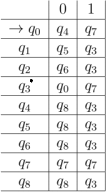Coursework 2 BASC0040
Hello, dear friend, you can consult us at any time if you have any questions, add WeChat: daixieit
Coursework 2 BASC0040
Student code:
In the exercises you may need to include handwritten parts of the step-by-step commented solution. Highlight the final result at the end and clearly refer to the exercise number.
The solution and all the passages and comments must be clear and readable; you must complete the answer sheet within the set time limit.
Ensure you save your work as you go along.
The final version must be uploaded in PDF format.
All the pages (question file, answers file and any other file you want to submit) must be submitted as a single PDF file.
The filename must be in the following format: CandidateCode-ModuleCode- Coursework2.pdf
The deadline for submission is January 24, 2023, 5 PM GMT (UK time).
Each question is worth 20pt.
Exercise 1:
1) Design a DFA that recognises all the strings over the alphabet {0, 1, F} (where F is the final symbol), containing EXACTLY one substring with AT LEAST four consecutive 1s.
2) Prove that the following language is not regular
L1 = {W = 0n 1n2}
Exercise 2:
1) Prove that the following language is context free but not regular (note 1: |w|
identifies the length of a string, note 2: the notation WR identifies w reversed, so if W = ab, WR = ba)
L2 = {WWR |W ∈ {a, b}, |W| even}
2) Convert the grammar generated in Chomsky Normal Form, and build a parse tree for baab.
Exercise 3:
1) Convert the following NFA into the equivalent DFA, showing the steps. After, draw the graph and determine the language recognised (note: star * means final states):

2) Minimise the following DFA, and draw the associated graph (here the final state is q3, apologies for not adding it in the table):

Exercise 4:
1) Provide a regex for the following languages.
a. L = {w|w ∈ {0, 1}∗, and does not end witℎ adouble cℎaTacteT} b. L = {w|w isapℎone numbeT accoTding to Hollywood Tules}.
Remember that pop culture wants that in the movies all phone numbers are strings of 7 numbers and a dash symbol, starting always with 555-, e.g., 555- 4178.
2) What is the Chomsky Hierarchy and how does it connect to the theory of formal
languages? Elaborate, explaining the theoretical results (max 100 words)
Exercise 5:
1) Prove that the following formula is valid by using FOL tableaux
∀x(∀y(T (x, y) → p(y)) ∧ ∃z ¬p(z) → ∃z ¬T (x, z))
2) Put the formula from point 1) in CNF.
2023-08-17